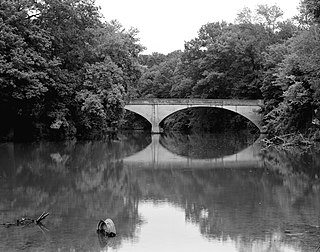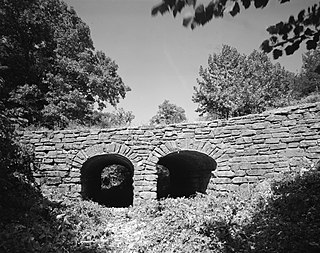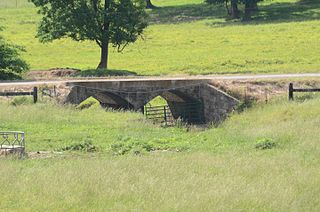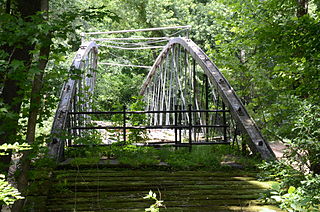
The Davies Bridge carries Red Bluff Drive across Cedar Creek, just north of Arkansas Highway 154 in Petit Jean State Park, Arkansas. It is a single-span closed-spandrel masonry arch structure, with an arch 20 feet (6.1 m) long and 10 feet (3.0 m) high. It is built out of mortared ashlar fieldstone laid in courses, with some stones left rusticated and protruding from the sides. The bridge was built in 1934 by a crew of the Civilian Conservation Corps that was developing the park's facilities.

The Cove Creek Bridge is a historic bridge, carrying Arkansas Highway 309 across Cove Creek, south of the hamlet of Corley, Arkansas in the Ozark-St. Francis National Forest. It is a two-span closed-spandrel masonry arch structure, with each span measuring 13 feet (4.0 m) and an overall structure length of 26 feet (7.9 m). It is built entirely out of stone, with a concrete and asphalt deck, and concrete barriers at the sides. It was built in 1936 with funding support from the Works Progress Administration.

The Illinois River Bridge, also known as the Midway Bridge, is a historic concrete arch bridge near Siloam Springs, Arkansas. It is located in Ozark National Forest, about 6 miles (9.7 km) east of Siloam Springs, at the end of Chambers Springs Road south of United States Route 412. The bridge has two elliptical arch spans, each spanning 68 feet (21 m), with a total structure length of 139 feet (42 m). Built in 1922 by the Luten Bridge Company of Knoxville, Tennessee, it is one of a modest number of bridges of this once-popular and common type remaining in the state.

The Self Creek Bridge is a historic bridge near Daisy, Arkansas. The open spandrel deck arch bridge carries U.S. Route 70 over Self Creek near its mouth at Lake Greeson. It was built in 1949 at a cost of $287,000. It has three spans, with a total length of 692 feet (211 m). The bridge was built because the construction of the dam which impounds the lake required re-routing of the highway.

The Samuel Morey Memorial Bridge is a historic bridge carrying New Hampshire Route 25A across the Connecticut River between Orford, New Hampshire and Fairlee, Vermont. The steel through-arch bridge was built in 1937–38 to replace an older wooden bridge which had been damaged by flooding in 1936. It spans 432 feet (132 m), stands about 35 feet (11 m) above the river, and its arches rise 85 feet (26 m) above the roadway. It rests on poured concrete abutments that have a light Art Deco or Moderne styling. Wing walls recede from the abutments into the banks in three stepped sections. Below the bridge in the river is visible some riprap, stone remnants of the old bridge's abutments and central pier. The bridge is of a "tied arch" design, in which the two arches are joined together by ties to distribute the active load. This is in contrast to the Justice Harlan Fiske Stone Bridge joining Brattleboro, Vermont and Chesterfield, New Hampshire, which was built about the same time, and distributes the active load to its abutments. The bridge components were manufactured by the American Bridge Company; construction was by Hagen-Thibodeau Construction Company at a contracted cost of just over $209,000.

The Crowley's Ridge State Park Bridge is a historic masonry stone arch bridge in Crowley's Ridge State Park, near Walcott, Arkansas. The bridge carries the main access road to the park across a drainage ditch. It is a rusticated stone structure, about 40 feet (12 m) long, that was built c. 1935 by crews of the Civilian Conservation Corps (CCC) that were developing the park. It is one of several CCC-built structures still standing in the park, and is a well-built example of the rustic architecture popularized by the CCC.

The Mulladay Hollow Bridge is a stone arch bridge in rural Carroll County, Arkansas. It carries County Road 204 across Mulladay Hollow Creek, near the southwestern tip of Lake Leatherwood. It has two spans, and is built out of roughly square and semi-coursed fieldstone. The arches are elliptical in shape, 9 feet (2.7 m) in height and 9.5 feet (2.9 m) wide, with nearly-square voussoirs forming the arches. The barrels of the arches are skewed with respect to the spandrels, and the wing walls are slightly curved. The roadway carried by the bridge is 30 feet (9.1 m) wide, and the total length of the structure is 120 feet (37 m). The bridge was built with Works Progress Administration funding as part of the development of Lake Leatherwood as a recreation area.

The Sanitarium Lake Bridges Historic District encompasses a pair of stone arch bridges on Carroll County Road 317 in southern Eureka Springs, Arkansas. Built in 1891 by the Eureka Sanitarium Company to provide access to its resort, they are the only known stone arch bridges in the county, and two of a small number of known surviving stone arch bridges in the entire state. Both bridges are single-span arches fashioned out of cut stone. Marble Bridge, the northern one, has a span of 44 feet (13 m) across a ravine, while the Lake Bridge has a span of 22 feet (6.7 m) over a normally dry creek bed.

The Goff Farm Stone Bridge is a historic bridge in eastern Fayetteville, Arkansas. It carries Goff Farm Road across an unnamed creek just north of Stonebridge Meadows Golf Club. The bridge is a single-span stone arch with a span of 20 feet (6.1 m) and a total bridge length of 150 feet (46 m). The bridge's builder is unknown, and its design suggests it was built c. 1860, when the road it carries was a major east–west thoroughfare connecting Fayetteville and Huntsville. It is believed to be the oldest masonry bridge in the state, and is one of the state's small number of surviving 19th-century stone bridges.

The Milltown Bridge is a historic stone arch bridge in rural southeastern Sebastian County, Arkansas. The bridge carries County Road 77 across an unnamed brook just west of its junction with White Mountain Road. It is a two-span closed spandrel structure, with each arch spanning 10 feet (3.0 m) and a total length of 24 feet (7.3 m). The arches are formed out of rough-cut stone voussoirs. It was built in the 1930s with funding from the Works Progress Administration, and was, when listed on the National Register of Historic Places in 1990, one of only eight documented bridges of its type in the state.

Shady Lake Recreation Area is a campground and public recreation area in southwestern Ouachita National Forest, southwest of Mena, Arkansas and west of Glenwood, Arkansas. The area is oriented around Shady Lake, a body of water on the South Fork Saline River impounded by a dam built c. 1940 by the Civilian Conservation Corps (CCC). The area is administered by the United States Forest Service (USFS).

The Cedar Creek Bridge is a historic bridge in rural southern Independence County, Arkansas. It is located on Goodie Creek Road, about 1.5 miles (2.4 km) south of its junction with Arkansas Highway 14. It is a two-span stone masonry structure, spanning Cedar Creek with two closed-spandrel arches having a total length of 30 feet (9.1 m). Its deck is 24.1 feet (7.3 m) wide, with a total structure width of 26.1 feet (8.0 m), including the parapets at the sides. The bridge was built 1941, and was probably designed by an engineer of the state's highway department.

The Harp Creek Bridge is a historic bridge in rural northern Newton County, Arkansas, carrying Arkansas Highway 7 across Harp Creek in the hamlet of Harrison. It is an open spandred arch bridge, built out of steel and concrete in 1928 by the Luten Bridge Company. The arches span 69 feet (21 m), and are mounted on piers set 24 feet (7.3 m) from the abutments. The total structure length is 117 feet (36 m), and the deck is 23 feet (7.0 m) wide. Concrete balustrades line the sides of the bridge.

The South Fork Bridge is a historic bridge spanning the South Fork Ouachita River in Fountain Lake, Arkansas. It formerly carried Arkansas Highway 128, whose modern bridge now stands just to the south, a short way east of its junction with Arkansas Highway 5. It is a two-span concrete closed-spandrel arch structure, with spans of 57 feet (17 m) and a roadway width of 16 feet (4.9 m). It was built in 1928 by a county crew, after major flooding in 1927 damaged road infrastructure in the area.

The Lake No. 1 Bridge is a historic bridge, carrying Avondale Road across the northern tip of Lake Number 1 in North Little Rock, Arkansas. It is a closed-spandrel stone arch bridge with Rustic styling, built in the 1920s as part of the Lakewood development promoted by developer Justin Mathews. It has a single elliptical arch, spanning 18 feet (5.5 m), with a total structure length of 30 feet (9.1 m). It was one of eight stone arch bridges built in the state between 1923 and 1939, and one of the few that was privately built.

The Lakeshore Drive Bridge carries a closed-off portion of Lakeshore Drive across a tributary stream on the west side of Lake Number 3 in North Little Rock, Arkansas. It is a stone arch bridge with closed spandrels and a total structure length of 53 feet (16 m). The bridge consists of a single elliptical curved arch, which spans 20 feet (6.1 m) and is 5 feet (1.5 m) high. Rustic square stone columns rise from the spandrels, creating uneven parapets on the sides of the structure. The bridge was built in the late 1930s as part of developer Justin Matthews' construction of the Lakewood area. It is one of a small number of documented masonry arch bridges in the state.

The Springfield Bridge is a historic bowstring truss bridge, located in Beaverfork Lake Park in Conway, Arkansas, USA. It originally spanned Cadron Creek in rural Faulkner County east of Springfield. It is 188 feet (57 m) long, set on stone abutments, with tubular metal top chords that rise 15 feet (4.6 m) above the bottom chords. Built circa 1871–74, it is the oldest documented highway bridge in the state and its only documented bowstring arch bridge.

The Main Street Bridge carries Sellers Street across a portion of the Silver Smith Branch in New Blaine, Arkansas. Built in 1922, it is a closed-spandrel masonry arch bridge, built out of locally quarried stone. It has a total length of 19 feet (5.8 m) and is about 20 feet (6.1 m) wide. It is named "Main Street Bridge" because Sellers Street was known as Main Street at the time of its construction, and was the principal route from the railroad depot to New Blaine's commercial and industrial area.

The Cove Creek Tributary Bridge is a historic bridge in rural Logan County, Arkansas. It is a two-span closed-spandrel stone arch bridge, carrying Arkansas Highway 309 across a tributary of Cove Creek north of Corley in Ozark-St. Francis National Forest. Each of its arches is 11 feet (3.4 m) long, and the structure is an overall 23 feet (7.0 m) in length. Concrete barriers form the sides of the bridge on either side of the roadway. The bridge was built in 1936 under the auspices of the Arkansas Highway Commission.

The Indian Lake Road Stone Arch Bridge is a former railroad bridge which now carries a hiking/biking path over Indian Lake Road, just east of M-24 near Orion, Michigan. It is one of only a small number of stone arch railroad bridges known to exist in Michigan. The bridge was listed on the National Register of Historic Places in 2005.






















